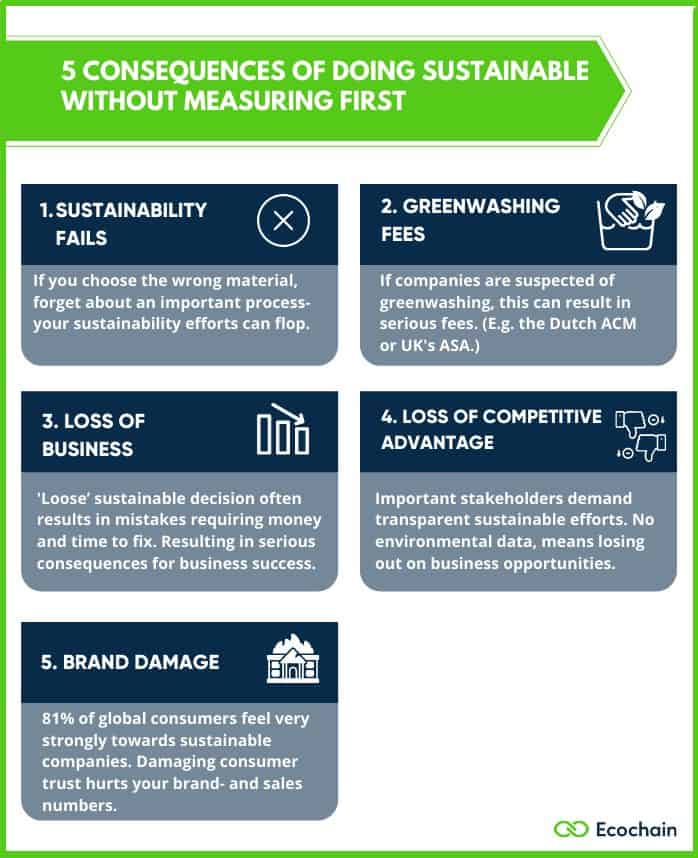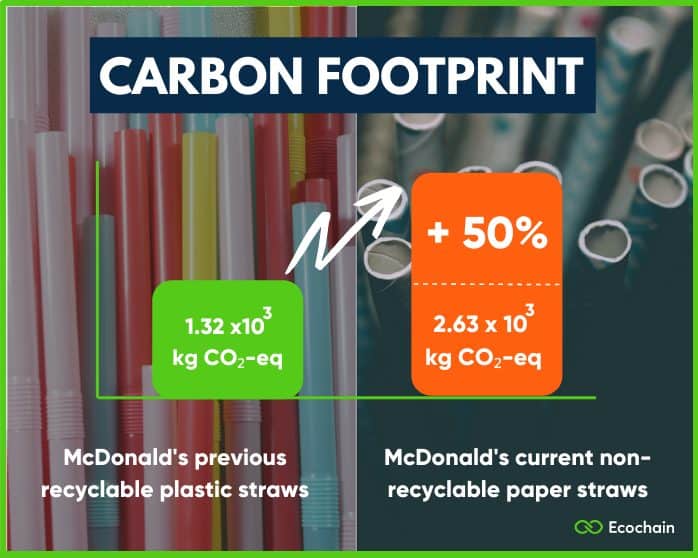It happens more often than you think.
Companies claim to be sustainable- just because they perceive certain actions as sustainable.
Often this goes together with actions that look good to external stakeholders.
But- how do you know if what you are doing is actually making your company more sustainable?
Making decisions based on…what?
The principle is simple. If you don’t have any- or correct environmental data in the first place, how do you know if what you are doing is making a difference?
Sometimes, companies’ actions to tackle sustainability can completely backfire. And that’s because thinking you know where your impact comes from. And actually knowing where it comes from- can have completely different outcomes.
Now- what’s the danger of not having environmental data to guide your sustainability decisions?
- Sustainability fails:
This dangerous result is the most obvious: random sustainability actions can turn into sustainability fails. Sustainability can be very tricky if you don’t have the insights to ignite or monitor improvements. If you (accidentally) choose the wrong material, or forget about an important process- your sustainability efforts can flop. And this can have serious business consequences.
- Greenwashing fees:
If companies are suspected of greenwashing, this can result in serious fees. In the Netherlands, watchdog ACM (Netherlands Authority for Consumers and Markets) makes sure that companies who make claims without evidence are ‘punished’. A heavy reaction increasing in many other countries, e.g. the UK’s Advertising Standards Authority.
- Loss of business:
Mistakes cost money. Especially if they hurt your business model. Sometimes a ‘loose’ sustainable decision results in actions that require even more effort when you finally do have the insights. With all the existing and upcoming sustainability regulations and reporting requirements (e.g. CSRD), making mistakes or doing half-work is simply a no-go.
- Loss of competitive advantage:
Sustainability often works top-down. Important stakeholders, such as your buyers or investors- demand transparent sustainable efforts and numbers to improve their own. This turns improved and credible environmental data into a competitive advantage. E.g in the Dutch construction sector- environmental scores have become a criterion to win tenders. The result: not having environmental data simply means you lose out on business opportunities.
- Brand damage:
A study conducted by Nielsen showed 81% of global consumers feel very strongly towards companies that help improve our environment. Customers demand credible and transparant sustainable action. They want to know if their purchasing decisions truly make a difference. Damaging customer trust or creating ‘greenwashing’ suspicion not only hurts your brand- it will also hurt your sales numbers.
Let’s see how these mistakes can look like in practice. And what we can learn from them.

Practical example: McDonald’s sustainable paper straws that can’t be recycled
In 2018, McDonald’s UK announced they were replacing their plastic straws (with the daily use being 1.8 million!) with 100% recyclable paper alternatives to cut down on single-use plastic waste. However, after the replacement process, a problem popped up.
Although their plastic straws could be recycled- their paper straws can’t. Because the recycling infrastructure for this specific paper material… simply does not exist yet. A choice that led to a higher environmental footprint than before. Let us explain.
Recyclable plastic straws vs. non recyclable paper straws
We calculated the carbon footprint of both products (the standard products) in our tool. This calculation incorporated every stage in the product’s lifecycle- from the production until the end-of-life phase (incineration, landfill or recycling). We calculated *two scenarios:
(1) Both straws are incinerated: The results showed a carbon footprint of 2.63 x 103 kg CO₂-eq for the paper straw vs. 2.33 x 103 kg CO₂-eq for the plastic straws. A small difference, but still in favor of plastic. The main difference in impact coming from: the production of the paper.
(2) Only plastic straws are recycled: The results showed a carbon footprint of 2.63 x 103 CO₂-eq for the paper straw (not recyclable) vs. 1.32 x 103 kg CO₂-eq for the plastic straw (recyclable). A significant difference due to the impact that can be deducted from recycling the plastic straws.
*Disclaimer: This calculation is performed for the best-and worst case scenario and assumes that either 100% of plastic straws are recycled or not. We are not advocating the use of plastic straws, but that decision-making without environmental data is dangerous if it doesn’t improve your environmental footprint.

Considering the whole product lifecycle
If McDonalds would have considered the entire lifecycle of their product when calculating their environmental footprint. They would have know the ‘recyclable’ ingredient choices they made for their paper straws would have not been in line with the data from the straws’ recycling phase.
The lessons learned:
1. Sustainability requires understanding of your product’s entire lifecycle:
- A decision you make in one phase (e.g. your production)- also influences the rest of them (e.g transport or recycling options). Meaning: If you choose a different main ingredient for your product. You need to ensure that it also guarantees the best possible outcome in every realistic end-of-life scenario (recycling, waste, etc.).
- In reality only 91% of all the previous plastic straws and now 100% of McDonalds paper straws aren’t- or can’t be recycled. This means that all these straws actually end up in the oceans, landfills or get incinerated. Impacting marine life, polluting soil, etc. You can- and should always aim to incorporate these recycling numbers in your footprint calculations.
2. Model and compare sustainable alternatives for the best result.
The realistic end-of-life scenarios of straws definitely don’t look great. So, perhaps another more sustainable material (bioplastics or biodegrable materials) or paper type (e.g. sugar beet paper) would have proven to be a better choice for McDonalds in tackling these end-of-life problems. These different scenarios with different ingredients can be modeled and compared with the support of environmental data.
3. Sustainability requires collaboration:
You can search for partners that can help you out with involving innovative new products (e.g. biodegrable straws) in your footprint calculations. Of course, search for partners that have or are willing to calculate their own footprint too. This gives you the correct environmental data to compare sustainable alternatives.
4. Model scenarios for the future, but don’t be too futuristic:
Although McDonalds paper straws are made of 100% recyclable papermaterials. It can take years before the corresponding recyclingsystem is in place. Until then, they are still polluting. So, if you use an innovative product- always ensure that it is actually applied in the correct way. (If it is recyclable, ensure the actual infrastructure is there too.)

